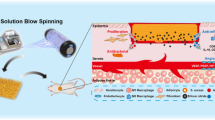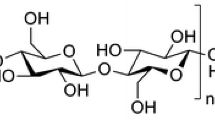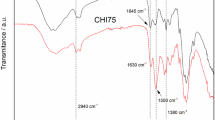Abstract
The aim of our study was obtaining chitosan–poly(vinyl alcohol)–neomycin sulfate films (Cs–PVA–Ne) by using solvent casting technique and the characterization of the products. The films were analyzed by Fourier transform infrared spectroscopy (FTIR), scanning electron microscopy, thermogravimetry (TG and DTG), differential scanning calorimetry (DSC), contact angle (CA) measurements, mechanical, and antibacterial activity tests. FTIR and DSC analysis demonstrated that interaction between Cs, PVA, and Ne took place. Static water CA measurements showed an improvement in the hydrophilicity of the Cs–PVA–Ne films. Also, the drug-loaded films proved to have fairly good mechanical strength and significant effects against Staphylococcus aureus and Escherichia coli. The unloaded films show minimum bacterial inhibition (~ 10.00 mm) compared to drug-loaded films (~ 30.00 mm). The bacterial inhibition was higher in all the cases of S. aureus than E. coli. Furthermore, PVA was found to improve the films properties. Due to their physical–chemical and mechanical features and the excellent antibacterial properties, the obtained Cs–PVA–Ne films are suitable for their use as wound-dressing materials.






Similar content being viewed by others
References
Li C, Fu R, Yu C, Li Z, Guan H, Hu D, Zhao D, Lu L (2013) Silver nanoparticle/chitosan oligosaccharide/poly(vinyl alcohol) nanofibers as wound dressings: a preclinical study. Int J Nanomed 8:4131–4145. https://doi.org/10.2147/IJN.S51679
Kamoun EA, Chen X, MohyEldin MS, Kenawy ES (2015) Crosslinked poly(vinyl alcohol) hydrogels for wound dressing applications: a review of remarkably blended polymers. Arab J Chem 8(1):1–14. https://doi.org/10.1016/j.arabjc.2014.07.005
Kokabi M, Sirousazar M, Hassan ZM (2007) PVA–clay nanocomposite hydrogels for wound dressing. Eur Polym J 43:773–781. https://doi.org/10.1016/j.eurpolymj.2006.11.030
Kiselioviene S, Baniukaitiene O, Harkavenko V, Babenko NA, Liesiene J (2016) Cellulose hydrogel sheets for wound dressings. Cellulose Chem Technol 50(9–10):915–923
Kamoun EA, Kenawy ERS, Chen X (2017) A review on polymeric hydrogel membranes for wound dressing applications: PVA-based hydrogel dressings. J Adv Res 8(3):217–233. https://doi.org/10.1016/j.jare.2017.01.005
Madaghiele M, Demitri C, Sannino A, Ambrosio L (2014) Polymeric hydrogels for burn wound care: advanced skin wound dressings and regenerative templates. Burns Trauma. https://doi.org/10.4103/2321-3868.143616
Darwhekar G, Jain DK, Choudhary A (2012) Elastic liposomes for delivery of neomycin sulphate in deep skin infection. Asian J Pharm Sci 7:230–240
Nitanan T, Akkaramongkolporn P, Rojanarata T, Ngawhirunpat T, Opanasopit P (2013) Neomycin-loaded poly (styrene sulfonic acid-co-maleic acid) (PSSA-MA)/polyvinyl alcohol (PVA) ion exchange nanofibers for wound dressing materials. Int J Pharm 448(1):71–78. https://doi.org/10.1016/j.ijpharm.2013.03.011
Straccia MC, d’Ayala GG, Romano I, Oliva A, Laurienzo P (2015) Alginate hydrogels coated with chitosan for wound dressing. Mar Drugs 13(5):2890–2908. https://doi.org/10.3390/md13052890
Bernabé P, Peniche C, Argüelles-Monal W (2005) Swelling behavior of chitosan/pectin polyelectrolyte complex membranes. Effect of thermal cross-linking. Polym Bull 55:367–375. https://doi.org/10.1007/s00289-005-0439-5
Ali NA, Al-Ajaj EA, Noori FTM (2013) Effect of nanoSiO2 additive of some mechanical and water absorption of polyvinyl alcohol/chitosan blends. ABC J Adv Res 1:36–41. https://doi.org/10.18034/abcjar.v2i1.426
Părpăriţă E, Cheaburu CN, Paţachia SF, Vasile C (2014) Polyvinyl alcohol/chitosan/montmorillonite nanocomposites preparation by freeze/thaw cycles and characterization. Acta Chemica Iasi 22(2):75–96. https://doi.org/10.2478/achi-2014-0008
Kouchak M, Ameri A, Naseri B, Kargar Boldaji S (2014) Chitosan and polyvinyl alcohol composite films containing nitrofurazone: preparation and evaluation. Iran J Basic Med Sci 17(1):14–20
Pereira VA Jr, Queiroz de Arruda IN, Stefani R (2015) Active chitosan/PVA films with anthocyanins from Brassica oleraceae (red cabbage) as time-temperature indicators for application in intelligent food packaging. Food Hydrocoll 43:180–188. https://doi.org/10.1016/j.foodhyd.2014.05.014
Nand AV, Rohindra DR, Khurma JR (2007) Characterization of genipin crosslinked hydrogels composed of chitosan and partially hydrolyzed poly(vinyl alcohol). e-Polymers. https://doi.org/10.1515/epoly.2007.7.1.402
Masti S, Kasai D, Mudigoudra B, Chougale R (2016) Effect of gum acacia (GA) on tensile properties of biodegradable chitosan (CS)/poly(vinyl alcohol) (PVA) polymer blend films. Res J Mater Sci 4(5):5–8
Chetouani A, Elkolli M, Bounekhel M, Benachour D (2017) Chitosan/oxidized pectin/PVA blend film: mechanical and biological properties. Polym Bull 74:4297–4310. https://doi.org/10.1007/s00289-017-1953-y
Maji P, Gandhi A, Jana S, Maji N (2013) Preparation and characterization of maleic anhydride cross-linked chitosan–polyvinyl alcohol hydrogel matrix transdermal patch. J Pharm Sci Tech 2(2):62–67
Abbaspour M, Makhmalzadeh BS, Rezaee B, Shoja S, Ahangari Z (2015) Evaluation of the antimicrobial effect of chitosan/polyvinyl alcohol electrospun nanofibers containing mafenide acetate. Jundishapur J Microbiol 8(10):e24239. https://doi.org/10.5812/jjm.24239
Elbarbary AM, El-Sawy NM (2017) Radiation synthesis and characterization of polyvinyl alcohol/chitosan/silver nanocomposite membranes: antimicrobial and blood compatibility studies. Polym Bull 74(1):195–212. https://doi.org/10.1007/s00289-016-1708-1
Fan L, Yang H, Yang J, Peng M, Hu J (2016) Preparation and characterization of chitosan/gelatin/PVA hydrogel for wound dressings. Carbohydr Polym 146(1):427–434. https://doi.org/10.1016/j.carbpol.2016.03.002
Chen CK, Huang SC (2016) Preparation of reductant-responsive N-maleoyl-functional chitosan/poly(vinyl alcohol) nanofibers for drug delivery. Mol Pharm 13(12):4152–4167. https://doi.org/10.1021/acs.molpharmaceut.6b00758
Das S, Subuddhi U (2016) Controlled and targeted delivery of diclofenac sodium to the intestine from pH-responsive chitosan/poly(vinyl alcohol) interpenetrating polymeric network hydrogels. Polym Sci Ser A 58(2):154–166. https://doi.org/10.1134/S0965545X16020048
Wang Q, Du YM, Fan LH (2005) Properties of chitosan/poly(vinyl alcohol) films for drug-controlled release. J Appl Polym Sci 96:808–813. https://doi.org/10.1002/app.21518
Hashemnia S, Mokhtari Z, Tashkhourian J, Moosavi-Movahedi AA (2015) Effect of covalent attachment of neomycin on conformational and aggregation properties of catalase. Indian J Biochem Biophys 52:189–195
Alhosseini SN, Moztarzadeh F, Mozafari M, Asgari S, Dodel M, Samadikuchaksaraei A, Kargozar S, Jalali N (2012) Synthesis and characterization of electrospun polyvinyl alcohol nanofibrous scaffolds modified by blending with chitosan for neural tissue engineering. Int J Nanomedicine 7:25–34. https://doi.org/10.2147/IJN.S25376
Abdelgawad AM, Hudson SM, Rojas OJ (2014) Antimicrobial wound dressing nanofiber mats from multicomponent (chitosan/silver-NPs/polyvinyl alcohol) systems. Carbohydr Polym 100:166–178. https://doi.org/10.1016/j.carbpol.2012.12.043
Agnihotri S, Mukherji S, Mukherji S (2012) Antimicrobial chitosan–PVA hydrogel as a nanoreactor and immobilizing matrix for silver nanoparticles. Appl Nanosci 2:179–188. https://doi.org/10.1007/s13204-012-0080-1
Berger J, Reist M, MayerJM Felt O, Gurny R (2004) Structure and interactions in chitosan hydrogels formed by complexation or aggregation for biomedical applications. Eur J Pharm Biopharm 57(1):35–52. https://doi.org/10.1016/S0939-6411(03),00160-7
Costa ES Jr, Barbosa-Stancioli EF, Mansur AAP, Vasconcelos WL, Mansur HS (2009) Preparation and characterization of chitosan/poly(vinyl alcohol) chemically crosslinked blends for biomedical applications. Carbohydr Polym 76:472–481. https://doi.org/10.1016/j.carbpol.2008.11.015
Liang S, Huang Q, Liu L, Yam KL (2009) Microstructure and molecular interaction in glycerol plasticized chitosan/poly (vinyl alcohol) blending films. Macromol Chem Phys 210:832–839. https://doi.org/10.1002/macp.200900053
Szekalska M, Sosnowska K, Zakrzeska A, Kasacka I, Lewandowska A, Winnicka K (2017) The influence of chitosan cross-linking on the properties of alginate microparticles with metformin hydrochloride-in vitro and in vivo evaluation. Molecules 22:182. https://doi.org/10.3390/molecules22010182
Chuang W-Y, Young T-H, Yao C-H, Chiu W-Y (1999) Properties of the poly(vinyl alcohol)/chitosan blend and its effect on the culture of fibroblast in vitro. Biomaterials 20:1479–1487. https://doi.org/10.1016/S0142-9612(99)00054-X
El-Hefian EA, Nasef MM, Yahaya AH (2011) Mechanical, thermal and surface investigations of chitosan/agar/PVA ternary blended films. E-J Chem 8(S1):S105–S112. https://doi.org/10.1155/2011/543587
Deepak K, Saraswati M, Ravindra C, Gani R (2015) Preparation and characterization of binary blend films containing chitosan and vanillin. Am J Adv Drug Deliv 3(2):181–195
El-Hefian EA, Nasef MM, Yahaya AH (2010) The preparation and characterization of chitosan poly (vinyl alcohol) blended films. E-J Chem 7(4):1212–1219. https://doi.org/10.1155/2010/626235
Cascone MG, Maltinti S, Barbani N (1999) Effect of chitosan and dextran on the properties of poly(vinyl alcohol) hydrogels. J Mater Sci Mater Med 10:431–435. https://doi.org/10.1023/A:1008983215833
Bahrami SB, Kordestani SS, Mirzadeh H, Mansoori P (2003) Poly (vinyl alcohol)-chitosan blends: preparation, mechanical and physical properties. Iran Polym J 12(2):139–146
Paul D, Paul S, Roohpour N, Wilks M, Vadgama P (2013) Antimicrobial, mechanical and thermal studies of silver particle-loaded polyurethane. J Funct Biomater 4(4):358–375. https://doi.org/10.3390/jfb4040358
Ciobanu C, Tura V, Dorohoi DO, Ciobanu LC (2006) Biopoliuretani. Ed Performantica, Iasi
El-Hefian EA, Nasef MM, Yahaya AH (2011) Preparation and characterization of chitosan/poly(vinyl alcohol) blended films: mechanical, thermal and surface investigations. E-J Chem 8(1):91–96. https://doi.org/10.1155/2011/969062
Straccia MC, Romano I, Oliva A, Santagata G, Laurienzo P (2014) Crosslinker effects on functional properties of alginate/N-succinyl chitosan based hydrogels. Carbohydr Polym 108:321–330. https://doi.org/10.1016/j.carbpol.2014.02.054
Joseph G, Koshy J, Kallanickal PM (2013) Tensile properties of PMMA/SAN blends at different temperatures. Int J Eng Sci Innov Technol (IJESIT) 2(5):341–344
Kanatt SR, Rao MS, Chawla SP, Sharma A (2012) Active chitosan–polyvinyl alcohol films with natural extract. Food Hydrocoll 29:290–297. https://doi.org/10.1016/j.foodhyd.2012.03.005
Ali M, Gherissi A (2017) Synthesis and characterization of the composite material PVA/chitosan/5% sorbitol with different ratio of chitosan. IJMME-IJENS 17(02):15–28
Vimala K, Mohan YM, Varaprasad K, Redd NN, Ravindra S, Naidu NS, Raju KM (2011) Fabrication of curcumin encapsulated chitosan–PVA silver nanocomposite films for improved antimicrobial activity. J Biomater Nanobiotechnol 2:55–64. https://doi.org/10.4236/jbnb.2011.21008
Mangala E, Suresh Kumar T, Baskar S, Panduranga Rao K (2003) Development of chitosan/poly(vinyl alcohol) blend membranes as burn dressings. Trends Biomater Artif Organs 17(1):34–40
Li M-C, Wu Q, Song K, Cheng HN, Suzuki S, Lei T (2016) Chitin nanofibers as reinforcing and antimicrobial agents in carboxymethyl cellulose films: influence of partial deacetylation. ACS Sustain Chem Eng 4(8):4385–4395. https://doi.org/10.1021/acssuschemeng.6b00981
Swathi V, Vidyavathi M, Prasad TNVKV, Suresh Kumar RV (2013) Comparison of different nano biocomposites of neomycin with marketed ointment by in vitro and in vivo evaluations. Int J Drug Deliv 5:438–448
Gowda ADV, Gowrav MP, Srivastava A, Osmani RAM (2016) A study of chitosan nanofibers containing neomycin sulphate for wound healing activity. Der Pharmacia Lettre 8(11):128–139
Acknowledgements
Silion M. is grateful for the financial support from the H2020 WIDESPREAD 2-2014: ERA Chairs Project no. 667387: SupraChemLab–Laboratory of Supramolecular Chemistry for Adaptive Delivery Systems, ERA Chair initiative, and a grant of the Romanian National Authority for Scientific Research and Innovation, CNCS/CCCDI—UEFISCDI, project number PN-III-P3-3.6-H2020- 2016-0011, within PNCDI III.
Author information
Authors and Affiliations
Corresponding author
Rights and permissions
About this article
Cite this article
Merlusca, I.P., Matiut, D.S., Lisa, G. et al. Preparation and characterization of chitosan–poly(vinyl alcohol)–neomycin sulfate films. Polym. Bull. 75, 3971–3986 (2018). https://doi.org/10.1007/s00289-017-2246-1
Received:
Revised:
Accepted:
Published:
Issue Date:
DOI: https://doi.org/10.1007/s00289-017-2246-1




